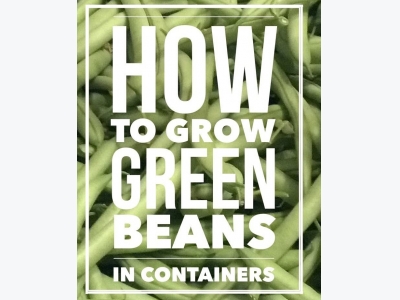How to Grow Great Green Geans In Containers

GREEN BEANS AND CONTAINERS: Pound for pound green beans are a nutritious, productive, and easy-to-grow crop. Beans adapt well to containers, so you can enjoy their crisp snap and tender taste even if you don’t have a plot of land.
TYPES OF GREEN BEANS
Both pole beans and bush beans grow well in containers. Pole beans are the tall, vining beans; they need support. The “beanstalk” Jack climbed up was probably a bean growing up a pole. Pole beans produce throughout the growing season and are easy to harvest.
Bush beans don’t need support, but they take up more room and you have to search inside the leafy bushes to find the beans.
Green beans, especially pole beans, are vulnerable to a number of plant diseases. It’s important to grow the varieties that are known to have the least pest problems in your area, and your local cooperative extension service will have that information. You can find the extension office nearest you through the U.S. Department of Agriculture website.
PLANTING GREEN BEANS
Green beans need warm soil to germinate. Sow seeds in your containers after the danger of frost is past, otherwise your seeds will rot or be slow to germinate. In most areas you can plant every two weeks through mid summer for a continuous supply of beans.
You can plant seeds of bush beans one inch deep and two or three inches apart in a two-gallon (or larger) container. You can sow pole bean seeds four-to-six inches apart in a long container with a trellis behind it. Or, you can sow three to four pole bean seeds around each pole in a half barrel. To prevent damage to seeds and plants, place the supports in the containers before you sow.
Whether you use buckets, barrels, planters made from scrap wood, or decorative terracotta pots, make sure your containers have drainage holes in the bottom. Cover the holes with wire or plastic mesh to prevent the soil from leaking out the bottom.
SOIL MIX FOR CONTAINER GREEN BEANS
Grow your beans in a well-drained soil mix that is high in organic content. You can buy a potting mix or make your own from equal parts of compost, garden loam, and clean, coarse builder’s sand or perlite.
HOW TO CARE FOR YOUR CONTAINER READY GREEN BEANS
Spread compost between the seeds. Water when the soil feels dry at a depth of two or three inches, and mulch to retain soil moisture. You might be surprised at how much water your beans need. Bigger containers require less frequent watering. Fertilize with a balanced liquid fertilizer at half-strength, organic fish emulsion, or a slow-release fertilizer. Inspect regularly for insects and diseases.
HARVESTING GREEN BEANS
Bush beans tend to mature all at once, while pole beans give an extended yield. Harvest when the beans are just full; don’t wait too long or your beans will be tough.
Related news
 6 Tips for Better Results Growing Strawberries
6 Tips for Better Results Growing Strawberries Strawberries are a versatile little fruit. From cereal/salad topper to smoothie flavoring to tart pastry filling, this is a fruit you can incorporate into break
 Create a Working Garden Plan
Create a Working Garden Plan The benefit of creating a garden plan is that you can discuss the layout with your family or client, and you can even create shapes to move around
 15 Gardening Tips for Growing Melons
15 Gardening Tips for Growing Melons Melons are some of the most popular fruits grown on the vine in the U.S. Many backyard gardens feature melons as a favorite late summer and early fall